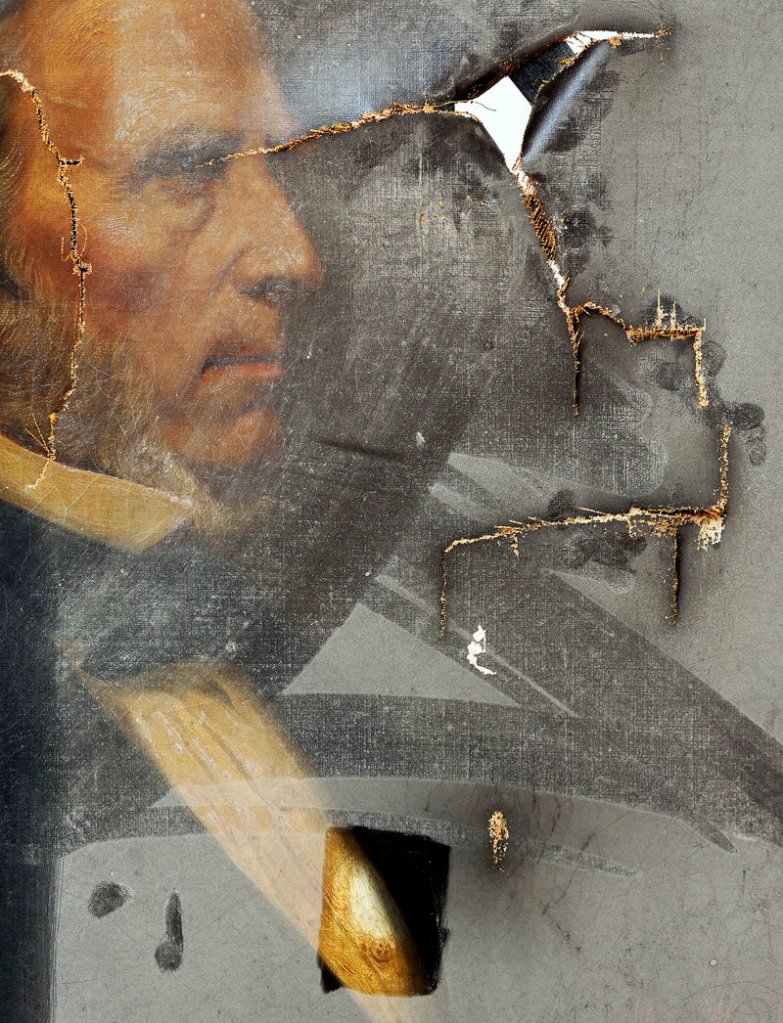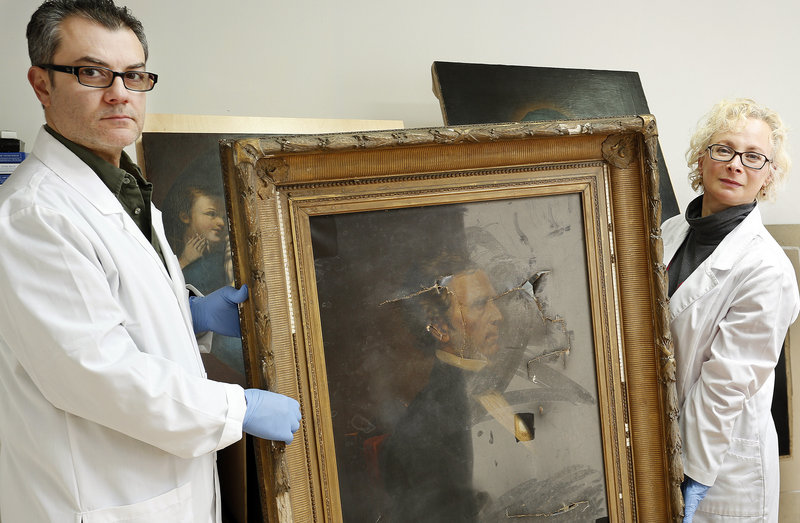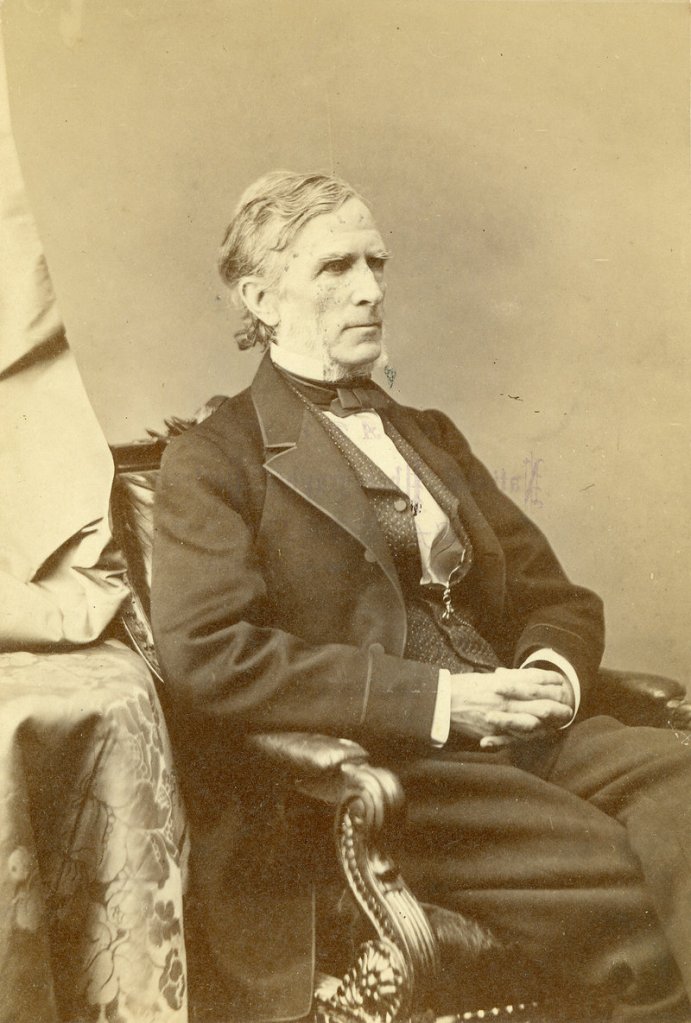PORTLAND – William Pitt Fessenden was a Mainer who made an impact on national politics.
He was a U.S. representative and senator in the 1840s and 1850s, and was President Lincoln’s treasury secretary in 1864 and 1865.
After that, he returned to the Senate, where he advocated Lincoln’s gentle approach to Reconstruction after the Civil War, rather than a more punitive process for reinstating the Southern states to the Union.
Portland, his hometown, named not just one, but three streets after him: William, Pitt and Fessenden.
So city officials and art conservationists were surprised a few weeks ago to find a dusty, torn oil painting of Fessenden stored along with several other paintings in the attic of City Hall.
Now, Fessenden’s portrait and about a dozen others will be restored by the Maine Project for Fine Art Conservation, at no cost to the city.
“This guy is really important,” said Bonnie Mattozzi, a project director. “He needs to be restored.”
The group will try to raise money for the restoration once it has completely assessed the condition of the paintings.
It’s unclear exactly when Fessenden’s portrait was removed from public display and why it was relegated to the attic.
It could have been careless oversight.
“History moves on,” said Earle Shettleworth Jr., the state historian. “As generations proceed, people may be less aware of the significance of a particular individual. Maybe at some point he gets replaced with someone more immediate in people’s minds.”
It also could have been a political statement.
Fessenden’s political career came to a controversial end in 1869 — the year he died — after he was one of just seven senators who voted against impeaching President Andrew Johnson in 1868, angering many in his own Republican Party and in his home state.
Johnson escaped impeachment by one vote in the Senate.
The so-called Radical Republicans led the impeachment charge, but Fessenden was more moderate and didn’t think Johnson’s abrasive attitude and Southern lineage warranted impeachment.
Anger at Fessenden was particularly acute in Maine, according to an article in the Maine Sunday Telegram in 1974.
Johnson was vice president for Lincoln’s second term. Before that, Hannibal Hamlin of Maine was Lincoln’s vice president. Had he stayed on, Hamlin, not Johnson, would have been president after Lincoln’s assassination in 1865.
Fessenden’s vote not to impeach Johnson was in direct opposition to the desire of his constituents. John F. Kennedy wrote about Fessenden’s decision is his book, “Profiles in Courage.”
Fessenden, who had a law practice in Portland and is buried in Evergreen Cemetery, also was a fierce abolitionist.
It is conceivable that his portrait was moved when the Ku Klux Klan held political sway at City Hall in the early 1900s.
In September 1923, a KKK rally in support of changing Portland’s elected-mayor form of government to a council-manager form of government to “rid city government of Jews and Catholics” drew 6,000 people.
Portland voters endorsed the change several days later, and in the next election, three of five KKK-endorsed candidates for City Council were elected.
“Maybe it was a political decision (to remove Fessenden’s portrait),” Shettleworth said. “There’s probably no way of knowing either way. Maybe the truth lies somewhere in between.”
It’s not the first Fessenden portrait that has been found in disrepair.
A painting was found “almost in rags” in a Department of Treasury cell or vault in Washington, D.C., according to a Maine Sunday Telegram article in 1956.
Descendants of Fessenden paid to have it restored, and it was put on display in the U.S. Treasury, the paper reported.
Another portrait of Fessenden hangs in the state Legislative Council chambers in Augusta, Shettleworth said.
Regardless of why the city’s portrait was put in storage, the Maine Project for Fine Art Conservation wants to ensure that it is fully restored and returned to prominence at City Hall.
Mattozzi said the painting will be removed from its frame and cleaned. The torn canvas will be put back together methodically with an adhesive and reinforced with an additional piece of canvas.
The process could take several years, Mattozzi said.
City spokeswoman Nicole Clegg said other paintings to be restored portray George P. Wescott (mayor 1873-1874), Charles F. Libby (mayor 1882), Fredericke E. Boothby (mayor 1901-1902), Cyrus H.K. Curtis (donor of the Kotzschmar Memorial Organ), James E. Barlow (city manager 1928-1946), Lyman S. Moore, Barnett I. Shur (the city’s general counsel 1946-1970) and Robert Ganley (city manager 1996-2000).
Mattozzi said this is the first time the Maine Project for Fine Art Conservation has had to raise money publicly for a restoration, but the group believes it will be a great opportunity to educate the public about Portland’s history, and about Fessenden in particular.
“He’s in rough shape,” she said, “but he’s going to be fine.”
Randy Billings can be contacted at 791-6346 or at:
rbillings@pressherald.com
Twitter: @randybillings
Send questions/comments to the editors.





